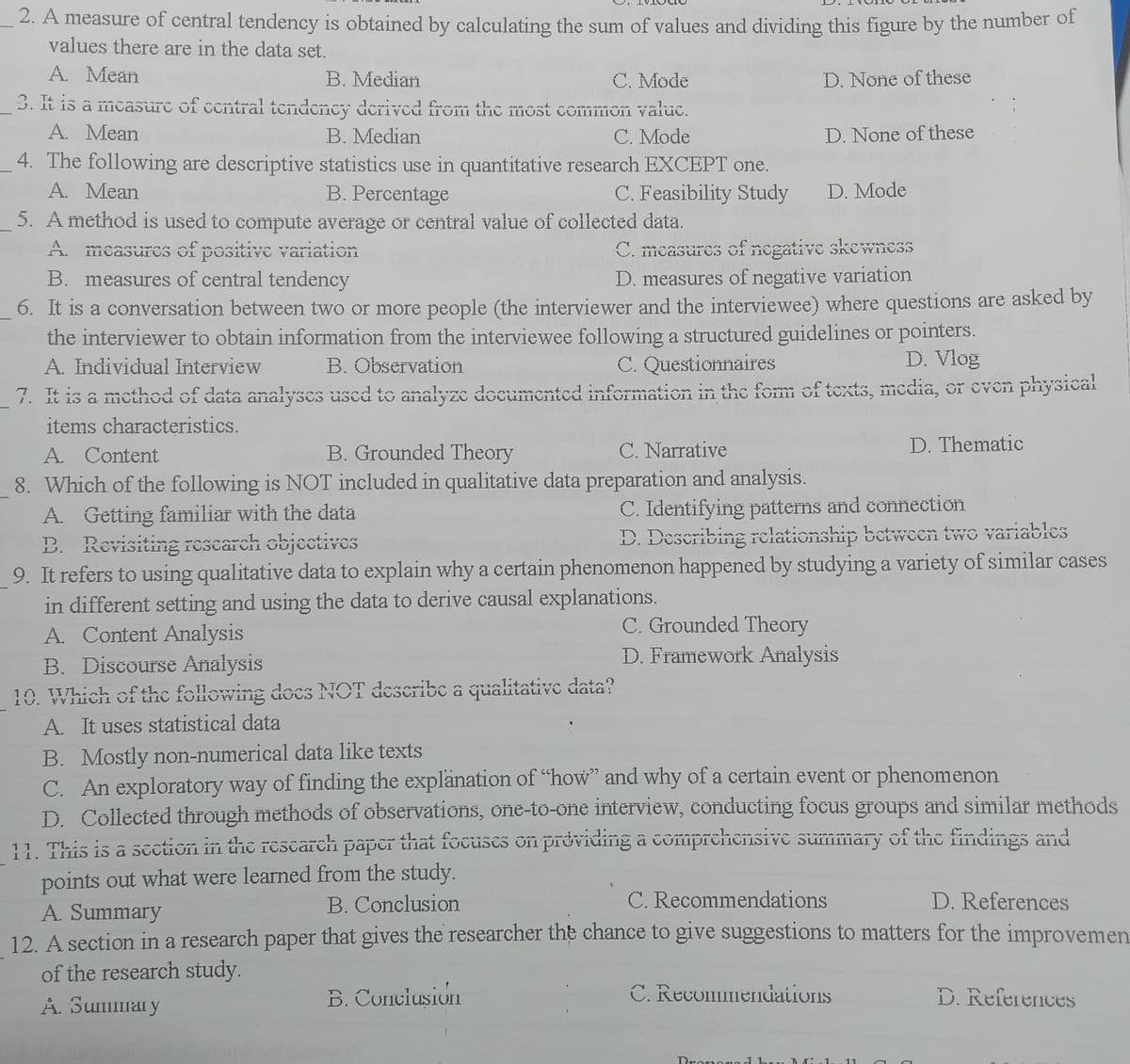2. A measure of central tendency is obtained by calculating the sum of values and dividing this figure by the number of values there are in the data set. A. Mean B. Median C. Mode D. None of these 3. It is a mcasurc of central tendency derived from the most common valuc. A. Mean B. Median C. Mode D. None of these 4. The following are descriptive statistics use in quantitative research EXCEPT one. B. Percentage A. Mean C. Feasibility Study D. Mode
2. A measure of central tendency is obtained by calculating the sum of values and dividing this figure by the number of values there are in the data set. A. Mean B. Median C. Mode D. None of these 3. It is a mcasurc of central tendency derived from the most common valuc. A. Mean B. Median C. Mode D. None of these 4. The following are descriptive statistics use in quantitative research EXCEPT one. B. Percentage A. Mean C. Feasibility Study D. Mode
Glencoe Algebra 1, Student Edition, 9780079039897, 0079039898, 2018
18th Edition
ISBN:9780079039897
Author:Carter
Publisher:Carter
Chapter10: Statistics
Section10.4: Distributions Of Data
Problem 19PFA
Related questions
Topic Video
Question

Transcribed Image Text:2. A measure of central tendency is obtained by calculating the sum of values and dividing this figure by the number of
values there are in the data set.
A. Mean
B. Median
C. Mode
D. None of these
3. It is a mcasurc of ccntrai tendency derived from the most comimon valuc.
A. Mean
B. Median
C. Mode
D. None of these
4. The following are descriptive statistics use in quantitative research EXCEPT one.
A. Mean
B. Percentage
C. Feasibility Study
D. Mode
5. A method is used to compute average or central value of čollected data.
A. mcasures of positive variation
B. measures of central tendency
6. It is a conversation between two or more people (the interviewer and the interviewee) where questions are asked by
the interviewer to obtain information from the interviewee following a structured guidelines or pointers.
A. Individual Interview
7. It is a method of data analyses used to analyze documented information in the form of texts, media, or even physical
items characteristics.
C. mcasures of negative skewnes
D. measures of negative variation
B. Observation
C. QuestionnaireS
D. Vlog
B. Grounded Theory
C. Narrative
D. Thematic
A. Content
8. Which of the following is NOT included in qualitative data preparation and analysis.
A. Getting familiar with the data
B. Revisiting rescarch objectives
9. It refers to using qualitative data to explain why a certain phenomenon happened by studying a variety of similar cases
in different setting and using the data to derive causal explanations.
A. Content Analysis
B. Discourse Analysis
10. Which of thc following docs NOT describc a qualitative data?
A. It uses statistical data
C. Identifying patterns and connection
D. Describing rclationship between two variables
C. Grounded Theory
Đ. Framework Analysis
a1:4へtivra nta
uala:
B. Mostly non-numerical data like texts
C. An exploratory way of finding the explänation of "how" and why of a certain event or phenomenon
D. Collected through methods of observations, one-to-one interview, conducting focus groups and similar methods
11. This is a scetion in the rescarch paper that focüses on providing â comprchensivE summary of the findings and
points out what were learned from the study.
A. Summary
12. A section in a research paper that gives the researcher the chance to give suggestions to matters for the improvemen.
of the research study.
A. Summary
B. Conclusion
C. Recommendations
D. References
B. Conciusion
C. Recommendations
D. References
Dronorod huu Bđi nla
.11
Expert Solution
This question has been solved!
Explore an expertly crafted, step-by-step solution for a thorough understanding of key concepts.
Step by step
Solved in 3 steps

Knowledge Booster
Learn more about
Need a deep-dive on the concept behind this application? Look no further. Learn more about this topic, statistics and related others by exploring similar questions and additional content below.Recommended textbooks for you

Glencoe Algebra 1, Student Edition, 9780079039897…
Algebra
ISBN:
9780079039897
Author:
Carter
Publisher:
McGraw Hill

Glencoe Algebra 1, Student Edition, 9780079039897…
Algebra
ISBN:
9780079039897
Author:
Carter
Publisher:
McGraw Hill